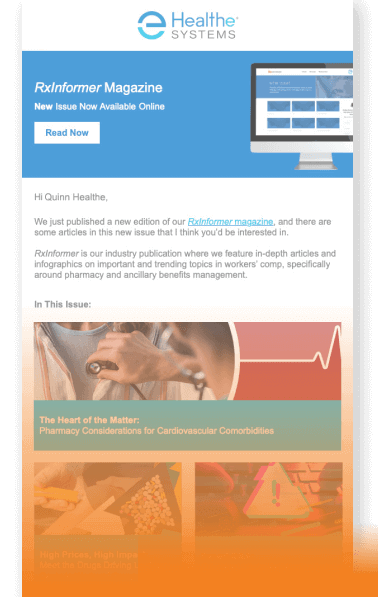
Sandy Shtab, Healthesystems VP of Industry and State Affairs, comments on regulatory activity across the country.
With a new administration in the White House, the nation is in a transition, creating uncertainty for business leaders, economists, and regulators. Recent months have seen more turbulence than previous transitions, with numerous Executive Orders and shifts in government oversight, foreign policy, and trade agreements.
And while the workers’ comp marketplace remains business as usual from a legislative and regulatory perspective, many executives have expressed concerns and consternation around the potential short-and-long-term impacts of recent Executive Orders, Cabinet appointments, and government directives.
Understanding the flurry of activity coming out of Washington D.C. requires a heightened level of awareness and critical thinking, as the speed of change and trajectory of those changes could have a downstream impact on workers’ comp, with virtually no stakeholder left untouched. The labor market is certainly impacted and therefore the changes will impact insurers, employers, medical providers, and others who provide services that support injured workers.
The directive to reduce federal bureaucracy has taken hold in the last few weeks, with reportedly hundreds of thousands of layoffs and voluntary resignations1 as a result of the Presidential Executive Order in February.2
This, in combination with the federal hiring freeze which went into effect on January 20th, 2025 remains in effect through late April.3 The Order also requires the Office of Personnel Management to produce a report outlining its plan to reduce government employee headcount though operational efficiency and attrition. These actions extended to all federal agencies and are a few that provide support to or help inform workers’ compensation regulation, policy or heath care. Some examples are as follows.
CMS is one of the sub-entities of Health and Human Services, where approximately 80,000 employees have been offered buyouts.1 While CMS is not directly connected to workers’ comp programs, it is a major supplier of reimbursement benchmark data, adjudication and coding rules, as well as coverage determinations, many of which are directly used or referenced within workers’ comp systems.
The Senate Appropriations Committee recently cited concerns about the impact layoffs will have on the administration of Medicare programs, including research which takes place at the National Institutes of Health clinical centers.4
As a sub-entity of the Department of Health and Human Services, FDA leadership is tasked with reducing headcount within similar parameters as other agencies. There is one notable exception which may provide some comfort to interested stakeholders; product reviewers and inspection staff who oversee or are directly engaged with drug approvals and new medical device testing are specifically excluded from buyout programs.
This will prevent any delays or disruption to existing timelines for FDA approvals for some, but not all heath products. Some are concerned about how digital therapeutics, surgical robotics, and even AI software that is intended to augment medical care may experience delayed progress due to staffing shortages.5
As a sub entity of the Centers for Disease Control and Prevention (CDC), this agency conducts research and collects data on work injury prevention. Many employees were terminated from the CDC and NIOSH, including researchers at the CDC’s Mining Safety Program, a group that studies the impacts of respiratory hazards which can lead to occupational diseases like Black Lung and Silicosis.
Furthermore, a number of workers in the Public Health Associate Program (PHAP) were also terminated.6 PHAP is a two-year, paid training program which helps recent college graduates prepare for jobs in the field of public health. Soon after these terminations, the administration rescinded about a third of the terminated employees in response to concerns about these agencies’ abilities to fulfill their mission.
The BLS and OSHA both fall under the authority of the DOL, and are largely responsible for setting standards and collecting and publishing statistical data and guidance that is relied upon by employers, actuaries and economists.
A few examples of reporting data include jobs reporting, hourly earnings reports, private industry compensation data, worker demographic data, and injury and illness reporting. If these standards or data are at risk in the future, there would have to be a reimagining of how the marketplace could operate in its absence. Many states have their own OSHA and Labor reporting, so any changes in this area may require further reliance on the states to fill in any gaps because of staffing reductions at the federal level.
Many employers and consumers are concerned about the impact of tariffs on consumer costs, especially for healthcare related items like drugs and medical devices produced overseas.7 Some experts have cited far-reaching impacts of tariffs on healthcare overall, with projections of medication hoarding as seen during the COVID-19 pandemic. There are also concerns around the potential of tariffs to create a chilling effect on research and development for new drug products, as well as increasing drug costs due to disruptions in the supply chain.
Carriers will need to consider how or if these changes will ultimately impact their underwriting and claim service delivery and costs. It is still too soon to determine how federal job cuts will affect claim counts or severity. In fact, recently published jobs data reflects no significant change in overall unemployment numbers in early 2025 as compared to 2024 data.8
While the federal workforce is reducing, there are signs it all may be economically neutral. The BLS data reflects increasing jobs in the healthcare, manufacturing and warehousing industries earlier this year. These may be due to predictions around staffing needs which could come from more US manufacturing. Only time will tell.
In concert with these actions, there are many healthcare advocates who have urged Congress and the White House to intervene and specifically insulate healthcare services from tariffs to protect patient accessibility to care. The Healthcare Distribution Alliance (HDA), the American Hospital Association (AHA), and others have issued statements expressing concerns about the potential impacts of tariffs.9-10
For instance, the HDA's statement on the proposed tariffs of pharmaceutical products emphasizes the need to exempt manufactured drugs and drug ingredients from these tariffs to maintain the existing supply chain and prevent disruptions to healthcare services for hospitals and patients. The AHA has also highlighted similar concerns last summer in their fact sheet on the impact of tariffs on healthcare equipment.11
Despite the many challenges and uncertainties posed by these recent federal actions, there is still a robust and healthy workers’ compensation system that exists to support injured workers in their recovery. As we saw during the pandemic, the healthcare sector can adapt to change, and technology enablement can be an important factor in supporting workers and claims staff during the claims process. As a nation, we have been through times of adversity and can make significant progress even when faced with uncertainty.
Through our collaborative efforts we can navigate through this uncertainty and continue to thrive. It will require continued vigilance and advocacy as an industry, combined with support and engagement from our state legislative bodies to protect our ability to serve employers and their injured workers. Working together to navigate these complexities is even more essential now than ever before.
Looking for state-specific policy updates? Visit our webpage for real-time state updates, an interactive map, and more insight from our Advocacy & Compliance team.
